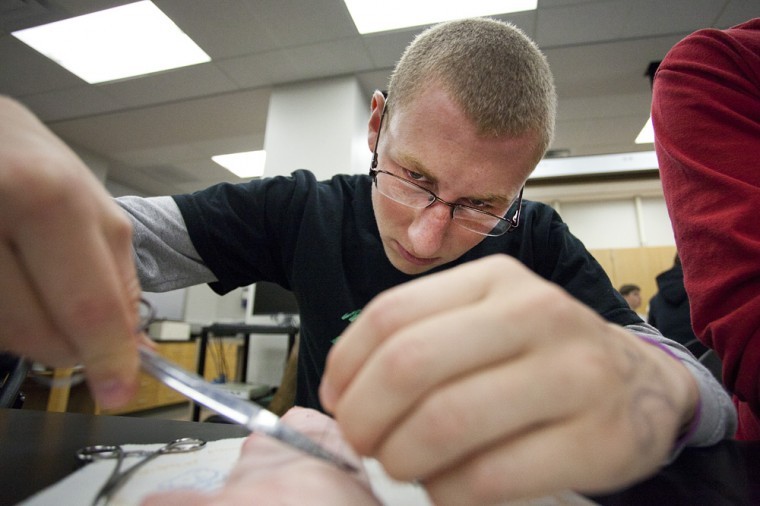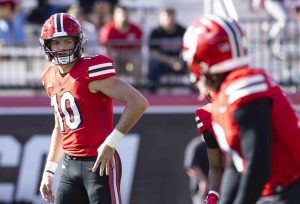WKU pre-medical club works hands-on for experience
November 11, 2011
Concentrating hard, Madisonville junior Matthew Wood stabbed the rough skin of a severed pig’s foot with a threaded scalpel and began sewing up the suture in the skin.
“I’ve done this before, but I was bad at it,” Wood said.
Carefully winding the thread through the thick, pink and somewhat bubbly skin, Wood sewed up the suture, or stitches, in the pig’s foot. He struggled to make a knot and then studied the dark thread’s pattern, looking unsure.
“Shit. How did he do it?” he asked his lab partner.
Wood was participating in Monday night’s annual pig suturing workshop for Alpha Epsilon Delta, the pre-medical honor society at WKU.
“Our membership is open to any health pre-professional,” said Lauren Bretz, the historian for Alpha Epsilon Delta. “Pre-dental, pre-optometry, pre-physical therapy – anything like that.”
Bretz said WKU’s chapter of AED has more than 70 members, many of whom are chemistry or biology majors, preparing for medical school. The suturing practice on pigs’ feet followed a lecture by Dr. Joseph Zaydon, a Bowling Green plastic surgeon, on Monday in Snell Hall.
In the laboratory in 3103 Snell Hall Monday night, more than 30 students were carefully weaving threaded scalpels through the cold skins of split pigs’ feet, trying out their suturing skills. Frequently, they looked to the overhead projector, where Kenneth Crawford, associate professor of biolog, was demonstrating the process on his own pig’s foot.
It was the first time practicing suturing on animal parts for many of the workshop participants.
Steven Milesko, an Elizabethtown senior, said medical students often practice surgery on pig parts because of the similarities between swine skin and human skin.
“Pig skin has the same consistency as human skin in terms of firmness,” Milesko said. He said that medical students also frequently use pigs’ hearts to practice the heart valve replacement procedure.
Bretz said the honor society’s annual pig suturing lab started last year and proved to be a popular event.
“It’s something we’re going to try to keep doing every year,” Bretz said.
Many of the students in the laboratory protected their hands with latex, but some students chose to forego the gloves. McCreary senior Adam Swiger said he did not mind touching the severed pigs’ feet.
“We just go with bare hands and skip all that stuff,” said Swiger.
He said that AED has had local physicians, dentists and surgeons as guest speakers throughout the semester.
Bretz said that AED is planning on holding more interactive workshops for its members. She said that earlier in the semester, AED had an intubation lab where a member of the Ohio County Emergency Medical Service showed the students how to intubate a patient using a mannequin.
“Later this semester, we might do some child psychology case studies – stuff like that,” Bretz said.
Crawford, who guided the students through the workshop, is a physiology professor and the director of WKU’s pre-medical program. He said it was early for the students to be practicing suturing, but that the value of the pigs’ feet lab was not really about gaining surgical skills. He said the real purpose is for the students gain a taste of what medical school might hold for them.
“I think what it does is give them a light at the end of the tunnel,” Crawford said. “It gives them something to look forward to – something to get excited about.”













